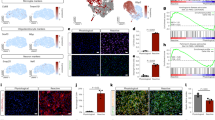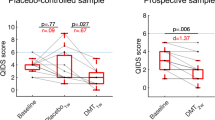Abstract
Induction of histone acetylation in the nucleus accumbens (NAc), a key brain reward region, promotes cocaine-induced alterations in gene expression. Histone deacetylases (HDACs) tightly regulate the acetylation of histone tails, but little is known about the functional specificity of different HDAC isoforms in the development and maintenance of cocaine-induced plasticity, and previous studies of HDAC inhibitors report conflicting effects on cocaine-elicited behavioral adaptations. Here we demonstrate that specific and prolonged blockade of HDAC1 in NAc of mice increased global levels of histone acetylation, but also induced repressive histone methylation and antagonized cocaine-induced changes in behavior, an effect mediated in part through a chromatin-mediated suppression of GABAA receptor subunit expression and inhibitory tone on NAc neurons. Our findings suggest a new mechanism by which prolonged and selective HDAC inhibition can alter behavioral and molecular adaptations to cocaine and inform the development of therapeutics for cocaine addiction.
This is a preview of subscription content, access via your institution
Access options
Subscribe to this journal
Receive 12 print issues and online access
$209.00 per year
only $17.42 per issue
Buy this article
- Purchase on Springer Link
- Instant access to full article PDF
Prices may be subject to local taxes which are calculated during checkout




Similar content being viewed by others
References
Kumar, A. et al. Chromatin remodeling is a key mechanism underlying cocaine-induced plasticity in striatum. Neuron 48, 303–314 (2005).
Levine, A.A. et al. CREB-binding protein controls response to cocaine by acetylating histones at the fosB promoter in the mouse striatum. Proc. Natl. Acad. Sci. USA 102, 19186–19191 (2005).
Kalda, A., Heidmets, L.T., Shen, H.Y., Zharkovsky, A. & Chen, J.F. Histone deacetylase inhibitors modulates the induction and expression of amphetamine-induced behavioral sensitization partially through an associated learning of the environment in mice. Behav. Brain Res. 181, 76–84 (2007).
Shen, H.Y. et al. Additive effects of histone deacetylase inhibitors and amphetamine on histone H4 acetylation, cAMP responsive element binding protein phosphorylation and DeltaFosB expression in the striatum and locomotor sensitization in mice. Neuroscience 157, 644–655 (2008).
Renthal, W. et al. Genome-wide analysis of chromatin regulation by cocaine reveals a role for sirtuins. Neuron 62, 335–348 (2009).
Maze, I. et al. Essential role of the histone methyltransferase G9a in cocaine-induced plasticity. Science 327, 213–216 (2010).
Malvaez, M., Mhillaj, E., Matheos, D.P., Palmery, M. & Wood, M.A. CBP in the nucleus accumbens regulates cocaine-induced histone acetylation and is critical for cocaine-associated behaviors. J. Neurosci. 31, 16941–16948 (2011).
Levine, A. et al. Molecular mechanism for a gateway drug: epigenetic changes initiated by nicotine prime gene expression by cocaine. Sci. Transl. Med. 3, 107ra109 (2011).
Kouzarides, T. Chromatin modifications and their function. Cell 128, 693–705 (2007).
Schroeder, F.A. et al. Drug-induced activation of dopamine D1 receptor signaling and inhibition of class I/II histone deacetylase induce chromatin remodeling in reward circuitry and modulate cocaine-related behaviors. Neuropsychopharmacology 33, 2981–2992 (2008).
Kim, W.Y., Kim, S. & Kim, J.H. Chronic microinjection of valproic acid into the nucleus accumbens attenuates amphetamine-induced locomotor activity. Neurosci. Lett. 432, 54–57 (2008).
Romieu, P. et al. Histone deacetylase inhibitors decrease cocaine but not sucrose self-administration in rats. J. Neurosci. 28, 9342–9348 (2008).
Sun, J. et al. The effects of sodium butyrate, an inhibitor of histone deacetylase, on the cocaine- and sucrose-maintained self-administration in rats. Neurosci. Lett. 441, 72–76 (2008).
Wang, L. et al. Chronic cocaine-induced H3 acetylation and transcriptional activation of CaMKIIalpha in the nucleus accumbens is critical for motivation for drug reinforcement. Neuropsychopharmacology 35, 913–928 (2010).
Malvaez, M., Sanchis-Segura, C., Vo, D., Lattal, K.M. & Wood, M.A. Modulation of chromatin modification facilitates extinction of cocaine-induced conditioned place preference. Biol. Psychiatry 67, 36–43 (2010).
Renthal, W. et al. Histone deacetylase 5 epigenetically controls behavioral adaptations to chronic emotional stimuli. Neuron 56, 517–529 (2007).
Broide, R.S. et al. Distribution of histone deacetylases 1–11 in the rat brain. J. Mol. Neurosci. 31, 47–58 (2007).
Montgomery, R.L. et al. Histone deacetylases 1 and 2 redundantly regulate cardiac morphogenesis, growth, and contractility. Genes Dev. 21, 1790–1802 (2007).
Montgomery, R.L. et al. Maintenance of cardiac energy metabolism by histone deacetylase 3 in mice. J. Clin. Invest. 118, 3588–3597 (2008).
Pierce, R.C. & Kalivas, P.W. A circuitry model of the expression of behavioral sensitization to amphetamine-like psychostimulants. Brain Res. Brain Res. Rev. 25, 192–216 (1997).
Badiani, A. & Robinson, T.E. Drug-induced neurobehavioral plasticity: the role of environmental context. Behav. Pharmacol. 15, 327–339 (2004).
Khan, N. et al. Determination of the class and isoform selectivity of small-molecule histone deacetylase inhibitors. Biochem. J. 409, 581–589 (2008).
Maze, I. et al. Cocaine dynamically regulates heterochromatin and repetitive element unsilencing in nucleus accumbens. Proc. Natl. Acad. Sci. USA 108, 3035–3040 (2011).
Dion, M.F. et al. Dynamics of replication-independent histone turnover in budding yeast. Science 315, 1405–1408 (2007).
Heiman, M. et al. A translational profiling approach for the molecular characterization of CNS cell types. Cell 135, 738–748 (2008).
Dixon, C.I. et al. Cocaine effects on mouse incentive-learning and human addiction are linked to alpha2 subunit-containing GABAA receptors. Proc. Natl. Acad. Sci. USA 107, 2289–2294 (2010).
Gregoretti, I.V., Lee, Y.M. & Goodson, H.V. Molecular evolution of the histone deacetylase family: functional implications of phylogenetic analysis. J. Mol. Biol. 338, 17–31 (2004).
Fischer, A., Sananbenesi, F., Mungenast, A. & Tsai, L.H. Targeting the correct HDAC(s) to treat cognitive disorders. Trends Pharmacol. Sci. 31, 605–617 (2010).
Guan, J.S. et al. HDAC2 negatively regulates memory formation and synaptic plasticity. Nature 459, 55–60 (2009).
McQuown, S.C. et al. HDAC3 is a critical negative regulator of long-term memory formation. J. Neurosci. 31, 764–774 (2011).
Bahari-Javan, S. et al. HDAC1 regulates fear extinction in mice. J. Neurosci. 32, 5062–5073 (2012).
Kurita, M. et al. HDAC2 regulates atypical antipsychotic responses through the modulation of mGlu2 promoter activity. Nat. Neurosci. 15, 1245–1254 (2012).
Lagger, G. et al. Essential function of histone deacetylase 1 in proliferation control and CDK inhibitor repression. EMBO J. 21, 2672–2681 (2002).
White, F.J., Hu, X.T., Zhang, X.F. & Wolf, M.E. Repeated administration of cocaine or amphetamine alters neuronal responses to glutamate in the mesoaccumbens dopamine system. J. Pharmacol. Exp. Ther. 273, 445–454 (1995).
Pierce, R.C., Bell, K., Duffy, P. & Kalivas, P.W. Repeated cocaine augments excitatory amino acid transmission in the nucleus accumbens only in rats having developed behavioral sensitization. J. Neurosci. 16, 1550–1560 (1996).
Churchill, L., Swanson, C.J., Urbina, M. & Kalivas, P.W. Repeated cocaine alters glutamate receptor subunit levels in the nucleus accumbens and ventral tegmental area of rats that develop behavioral sensitization. J. Neurochem. 72, 2397–2403 (1999).
Boudreau, A.C. & Wolf, M.E. Behavioral sensitization to cocaine is associated with increased AMPA receptor surface expression in the nucleus accumbens. J. Neurosci. 25, 9144–9151 (2005).
Kauer, J.A. & Malenka, R.C. Synaptic plasticity and addiction. Nat. Rev. Neurosci. 8, 844–858 (2007).
Brown, T.E. et al. A silent synapse-based mechanism for cocaine-induced locomotor sensitization. J. Neurosci. 31, 8163–8174 (2011).
Kelz, M.B. et al. Expression of the transcription factor deltaFosB in the brain controls sensitivity to cocaine. Nature 401, 272–276 (1999).
Covington, H.E. III et al. A role for repressive histone methylation in cocaine-induced vulnerability to stress. Neuron 71, 656–670 (2011).
Lee, K.W. et al. Cocaine-induced dendritic spine formation in D1 and D2 dopamine receptor-containing medium spiny neurons in nucleus accumbens. Proc. Natl. Acad. Sci. USA 103, 3399–3404 (2006).
Bertran-Gonzalez, J. et al. Opposing patterns of signaling activation in dopamine D1 and D2 receptor-expressing striatal neurons in response to cocaine and haloperidol. J. Neurosci. 28, 5671–5685 (2008).
Lobo, M.K. et al. Cell type-specific loss of BDNF signaling mimics optogenetic control of cocaine reward. Science 330, 385–390 (2010).
Lee, T.I., Johnstone, S.E. & Young, R.A. Chromatin immunoprecipitation and microarray-based analysis of protein location. Nat. Protoc. 1, 729–748 (2006).
Acknowledgements
The authors would like to thank R. Neve (Massachusetts Institute of Technology) for viral vectors and M. Baxter for statistical expertise. This work was supported by grants from the US National Institute on Drug Abuse and National Institute of Mental Health (E.J.N.) and the Canadian Institutes for Health Research (P.J.K.; MFE 90086).
Author information
Authors and Affiliations
Contributions
P.J.K., I.M. and E.J.N. designed research; P.J.K., J.F., A.J.R., A.B., D.C. and D.M.D.-W. performed research; P.J.K., A.J.R., D.C. and A.B. analyzed data; R.B.-D. and E.N.O. contributed mutant mice; S.J.H. provided reagents; E.M. generated viral vectors; M.-H.H. contributed to data interpretation; P.J.K. and E.J.N. wrote the paper.
Corresponding author
Ethics declarations
Competing interests
The authors declare no competing financial interests.
Supplementary information
Supplementary Text and Figures
Supplementary Figures 1–4 (PDF 917 kb)
Rights and permissions
About this article
Cite this article
Kennedy, P., Feng, J., Robison, A. et al. Class I HDAC inhibition blocks cocaine-induced plasticity by targeted changes in histone methylation. Nat Neurosci 16, 434–440 (2013). https://doi.org/10.1038/nn.3354
Received:
Accepted:
Published:
Issue Date:
DOI: https://doi.org/10.1038/nn.3354
This article is cited by
-
Oxycodone withdrawal induces HDAC1/HDAC2-dependent transcriptional maladaptations in the reward pathway in a mouse model of peripheral nerve injury
Nature Neuroscience (2023)
-
Drug addiction: from bench to bedside
Translational Psychiatry (2021)
-
Injury triggers fascia fibroblast collective cell migration to drive scar formation through N-cadherin
Nature Communications (2020)
-
Cocaine Induces Inflammatory Gut Milieu by Compromising the Mucosal Barrier Integrity and Altering the Gut Microbiota Colonization
Scientific Reports (2019)
-
A potential role for the gut microbiome in substance use disorders
Psychopharmacology (2019)



